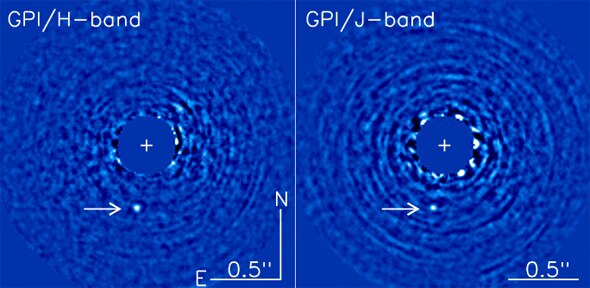Create a free profile to get unlimited access to exclusive videos, sweepstakes, and more!
51 Eridani b: Baby Pictures of a New Planet

Since the first alien world was discovered orbiting a Sun-like star in 1995, we’ve found thousands more. The vast majority have been detected using the transit method, where the planet passes directly in front of its host star, dimming the light just a wee bit. But other methods have yielded results, too, and I think the most exciting is direct imaging: literally taking a picture of the planet next to its star.
That’s hard to do, since the star can outshine the planet by a billion times. But new tech is making it easier. The Gemini Planet Imager is a camera on the 8-meter Gemini South telescope in Chile, and astronomers have been using it to survey young, nearby stars. Planets that are young glow in the infrared, making them easier to see (stars are fainter in IR than in visible light).
One of their first targets was the star 51 Eridani, a hot star that’s about 20 million years old and 100 light-years away. Guess what they found?
Well, you don’t have to guess! The picture above shows it: 51 Eri b, a planet somewhere between two and 12 times the mass of Jupiter, roughly the same physical size as Jupiter, and orbiting the star about 2 billion kilometers out (roughly twice the distance of Saturn from the Sun). The planet is clearly seen in the infrared once the star’s light is subtracted off. The observations were made in late 2014 and early 2015, so no orbital motion of the planet has (yet) been seen.* Still, the chance of it being some random background object are extraordinarily low.
The astronomers were also able to get spectra of 51 Eri b, breaking its light up into individual colors. This allowed them to look at the atmospheric composition of the planet, and they found strong indicators of the presence of water vapor and methane. That’s interesting! Other exoplanets observed in this way have not shown much in the way of those two molecules.
This may be in part because 51 Eri b is cooler than many others observed this way; looking in the infrared selects for hotter planets, which are brighter. Most of the other directly imaged planets have wider orbits and are more massive, as well. This planet is midway between those planets and ones more like Jupiter; exoplanets that are Jupiter-sized are very difficult to photograph indeed.
But tech gets better all the time. When we first discovered exoplanets their numbers came in as dribs and drabs, then a trickle, then a roar. The Gemini Planet Imager is cutting-edge today, but in 10 years, who knows? We’ve got direct photographs of a score of exoplanets now (see the gallery of them … and hmmm, it may be time to update it!), but that number will go up by leaps and bounds. Count on it.
Want to know more about exoplanets? Here’s my Crash Course Astronomy episode on them!
*A planet orbiting the star Beta Pictoris has been incontrovertibly seen to orbit the star, as a counterexample. This sort of motion is difficult to detect for most exoplanets due to their slow orbital motion.


























